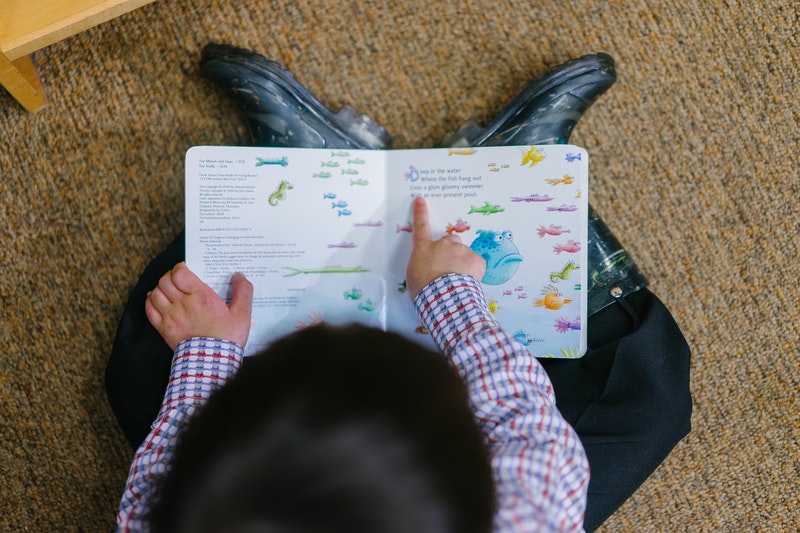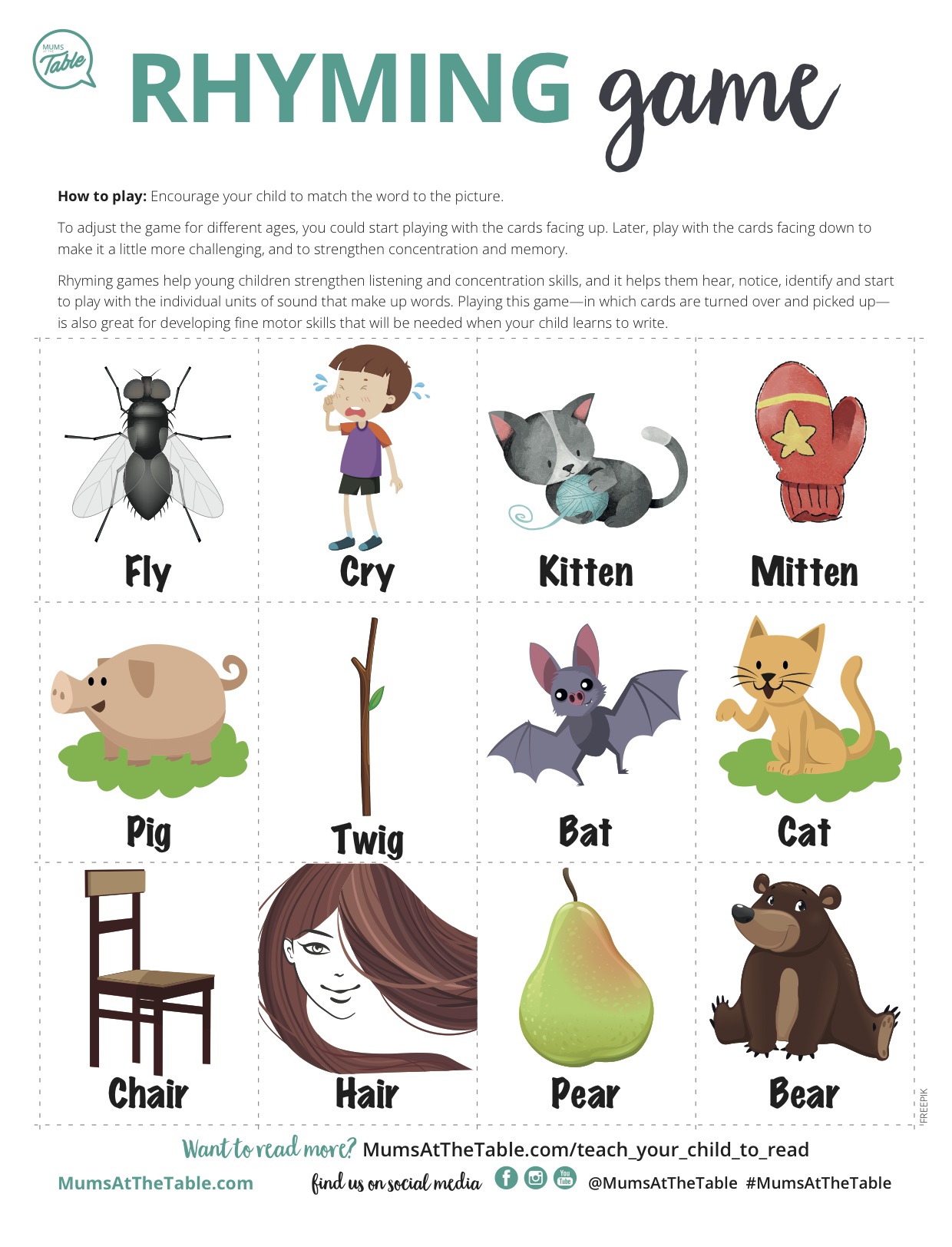There are some simple activities you can do at home from an early age that will teach your child to read. We also have a free printable below that you can use as a game to play with beginning readers.
Helping your child become a successful communicator is one of the greatest gifts a parent can give. Much of it will happen naturally, without you making any special effort. But some of it won’t, and it’s a tragedy to see a young child unable to effectively express themselves.
Let me hasten to assure you this isn’t about getting out the flash cards at home to do sight-words with your two-month-old . . . or any-month-old, for that matter. Leave primary school work for primary school. That’s not your job.
Read: Literacy expert: Here’s how children develop literacy
While all children are unique and develop to different timelines, as well as sometimes having individual developmental challenges, there are some simple things you can naturally work into your time spent with your children at home to help set them on the path to literacy—and communication—success.
3 main ways to teach your child to read
Teaching literacy skills fall into three main categories: communicating, reading and rhyme.
1. Communicating
Talk to your child from day one. Or better yet, talk with your child. Two-way communication with your baby helps them learn to speak, listen and understand. It also sets them up for early reading and gives them the essential skills to build up their language ability.
Listen or watch for their response and acknowledge it and continue the conversation. This doesn’t have to be constant—it’s OK to have periods of quiet, smiles, eye contact and loving touch too.
A lot of the time, children will learn new words and build their vocabulary quite naturally just by interacting with their world. But sometimes you need to take the time to explain some common words we take for granted as adults.
We did a lot of flying when my daughter was young and I would often talk about catching the plane. One day, after we’d arrived in Perth, we were in a shopping centre carpark when Liberty saw a plane flying overhead. She reached her arms upward and swung them in a grabbing motion, while saying, “Catch! Catch!”, much as if she was trying to catch a ball. I wondered what on earth was going through her head, when it suddenly clicked: She was trying to “catch” the plane, as I had so often talked about doing!
On another occasion, we were getting in the car to go shopping. I placed Liberty in her booster seat, in the back seat as always, but she was most upset.
“I want to sit in the back!” she demanded.
When I informed her that she was sitting in the back, she paused for the briefest of moments, then resumed her slightly amended chorus, “I want to sit in the front!”
Front, back. Light, dark. Spoon, fork. Red, blue. Catch a plane, catch a ball, catch a cold. There are so many words (labels) for a young child to learn and so many of those words have multiple shades of meaning. Young children are primed and ready for the task, just waiting for a little help from their caregivers.
Do these things at home:
- Talk with your child about the everyday things you’re doing and seeing together. For example, “Let’s get the washing now”, “Look at the red bird” or “Yum, what a nice lunch we’re having”.
- At meal times, talk about the food you’re preparing, what you’re doing to it, how it tastes and what it looks like.
- Talk about objects outside the house. For example, the rustling of leaves, or the sounds of the birds or traffic. Ask your child if they can make the sounds for wind, rain, water, airplanes, trains and cars.
- Play games like “I spy”, using colours. This can be lots of fun, especially for pre-schoolers. For example, “I spy with my little eye, something that’s green.”
- Repeat mispronounced words with the correct pronunciation. For example, if your child says “pasghetti”, you can say, “Yes, we’re having spaghetti for dinner.”
2. Reading

Reading with your child helps them understand how the printed word works and builds on their phonics skills—connecting sounds with letters. It also grows their vocabulary and help them develop a love of reading: the excitement of a story, the fun of rhyme, the fascination of facts.
Reading broadens a child’s world and is one of the most important things you can do to give your child a solid foundation for future literacy. You don’t need to teach your child to read per se—school-age children will learn that from their primary school teacher.
But you need to bring them to a level where they are ready, able and eager to learn.
Build up your child’s reading skills by reading often with them, aiming for at least once a day. You can do this from birth, but it’s never too late to start and you may well find your older children will still enjoy being read to sometimes. In fact, my husband still enjoys being read to!
Do these things at home:
- Choose lift-the flap books, touch-and-feel books or books with rhyming or repeating words for younger children.
- Encourage your child to hold the book and turn the pages. This helps them start to understand that the book should be a certain way up and that pages are always turned in the same direction.
- Make the sounds of animals or other objects in the book—have fun!
- Visit the library. There are many different types of books you can borrow—ask the librarian for suggestions.
Read: 10 of the best learn to read books
3. Rhyme
Rhyme further helps children learn about the connection between letters and sound, and it helps make reading fun! It exposes them to different sounds, building phonemic awareness and makes it easier when they are learning to read.
Do these things at home:
- Play word games that involve rhyming. “I spy with my little eye, something that rhymes with toad.” Or perhaps make your own cards with rhyming words to play Memory or Concentration. (Check out our free printable below made just for this!)
- Read rhyming books.
Developing early readers
Remember though, no-one is expecting perfection from you. Parenting is a hard gig—we know that. But many people aren’t aware of how they can do a few simple things to enrich their child’s foundation for learning and literacy.
It is important to point out however, that as a parent, our goal at home shouldn’t be about pushing our children to excel academically. Many parents mistakenly believe because a child’s brain grows so phenomenally in the first few years, it needs to be stimulated constantly.
Teaching your child to read—teaching them a love for learning and literacy—is not about raising the IQs of our children. Happiness and security should still be a parent’s ultimate goal for their child, not academic success.
A few not-so-obvious elements for growing good readers
- Eat well and avoid sugar and junk food. Drink water. A child who eats healthily is likely to have a greater capacity for patience, concentration and listening, and to calmly explore their world.
- Explore outside, have undirected play, build with blocks, touch scrunchy things, race toy cars. All these tactile experiences have multiple benefits, not least of which is helping to develop the essential components and fine motor skills children need when they start to learn to write.
- Manage screen time effectively and find a healthy balance. In 2017, the Canadian Paediatric Society recommended no screen time at all for babies up to two years old. They cautioned that “there is emerging evidence that [regular screen time for infants] can lead to problems with sleeping and learning, as well as an increased risk of obesity . . . and while there is evidence some educational content has benefits for older toddlers, particularly in terms of developing language and literacy, it still pales in comparison to old-fashioned parenting.”
The Australian Government Department of Health has the same recommendations, noting that “TV watched in the first two years of life may be connected with delays in language development” and may also “reduce the length of time young kids can stay focused [and] affect the development of the full range of eye movement.”
Free printable: Rhyming game for learning to read

How helpful was this article?
Click on a star to rate it!
5 / 5. 1
Be the first to rate this post!
Julie Hoey
Related posts
Subscribe
Receive personalised articles from experts and wellness inspiration weekly!

